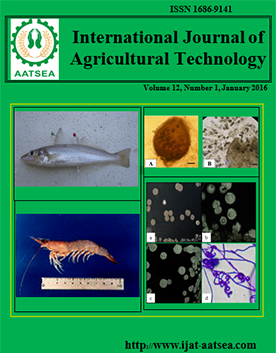Population dynamics of the greasyback shrimp (Metapenaeus ensis, De Haan, 1844) in the Songkhla Lake, Songkhla Province, Thailand
Main Article Content
Abstract
The dynamic mathematical models (e.g., Beverton and Holt 1957, 1966), useful for predicting future yields and stock biomass at different levels of fishing strategies, are extensively used for defining management strategies. The knowledge about growth and mortality of fish populations is an essential pre-requisite for the derivation of these models. In tropical and sub- tropical waters, despite the difficulty in determining age of fish and shrimps, the dynamic pool models have, unfortunately, been under-utilized for defining management strategies in fisheries. The present study was therefore designed to investigate the population dynamics of Metapenaeus ensis in Songkhla Lake. Samples were obtained monthly for (during January 2010 to Janauary, 2011) a period of thirteen month from Songkhla Lake. The samples were collected using trap nets. The population dynamics of Metapenaeus ensis from the Songkhla Lake was investigated based on catch/effort and length frequency data, using FiSAT software. Asymptotic size (L∞), growth coefficient (K), total (Z) and natural (M) mortality, exploitation rate (E), recruitment pattern. The result showed population dynamics of Metapenaeus ensis was divided into two group.The result in group C was showed the asymptotic length (L∞) and the growth rate constant (K) were estimated to be 16.74 cm and 1.80 yr−1 . The fishing mortality coefficients were 2.50. The natural mortality was estimated at 3.16 yr−1.The instantaneous total mortality (Z) 5.66 yr−1. The exploitation ratio (E) 0.44.The result in group H was showed the asymptotic length (L∞) and the growth rate constant (K) were estimated to be 14.57 cm and 2.30 yr−1. The fishing mortality coefficients were 2.05. The natural mortality was estimated at 3.86 yr−1.The instantaneous total mortality (Z) 5.91 yr−1.The exploitation ratio (E) 0.35.
Article Details

This work is licensed under a Creative Commons Attribution-NonCommercial-NoDerivatives 4.0 International License.
References
Beverton, R. J. H. and Holt, S. J. (1957). On the dynamics of exploited fish populations. Fisheries Investigations 19-2:1-533.
Beverton, R. J. H and Holt, S. J. (1966). Manual of methods for fish stock assessment-Part 2-Tables of yield functions. Food and Agriculture Organization of the United Nations. 67 pp.
Cha, H. H., Choi, J. H. and Oh, C. W. (2004). Reproductive biology and growth of the shiba shrimp Metapenaeus joyneri (decapoda: penaeidae) on the Western coast of Korea. Journal Crustacean Biology 24:93-100.
Cheung, T. S. (1964). Contributions to the knowledge of the life history of Metapenaeus ensis and other economic species of penaeid prawns in Hong Kong. Applied Ecology 1:369-386.
Chu, K. H. and So, B. S. H. (1987). Changes in salinity tolerance during larvae development of the shrimp Metapenaeus ensis (De Haan, 1844). Asian Marine Biology 4:41- 48.
Chu, K. H., Chen, Q. C., Huang, L. M. and Wong, C. K. (1995). Morphometric analysis of commercially important penaeid shrimps from the Zhujiang estuary, China. Fisher Research 23:83-93.
Courtney, A. J., Dredge, M. C. L. and Masel, J. M. (1989). Productive biology and spawning periodicity of endeavour shrimp Metapenaeus endeavour (Schmitt, 1029) and M. ensis (De Hann, 1850) from central Queensland. Australia Asian Fisher Science 3:133-147.
Crocos, P. J., Park, I. C., Die, D. J., Warburton, K. and Manson, F. (2001). Productive dynamics of endeavour prawns, Metapenaeus endeavouri and M. ensis, in Albotross Bay, Gulf of Carpentaria, Australia. Marine Biology 138:63-75.
Dadzie, S., Manyala, J. O. and Abou-Seedo, F. (2005). Aspects of the population dynamics of Liza klunzingeri in the Kuwait Bay. Cybium 29:13-20.
Dall, W., Hill, J., Rothlisberge, C. P. and Staples, D. J. (1990). Marine biology: The biology of the penaeidae. Academic Press 27:489.
Dineshbabu, A. P. and Manissery, J. K. (2008). Reproductive biology of ridgeback shrimp Solenocera choprai (Decapoda, Penaeoidea, Solenoceridae) off Mangalore coast, South India. Fisheries Science 74:796-803.
Holthuis, L. B. (1980). FAO species catalogue. In shrimps and prawns of the world. FAO Fish. Synop 125:1-271.
Fischer, W. and Bianchi, G. (1984). Western Indian Ocean, Fishing Area 51. In species identification sheets for fishery purposes. Food and Agriculture Organization of the United Nations. pp. 130.
Garcia, S. (1985). Reproduction, stock assessment models and population parameters in exploited penaeid shrimp populations. In second australian national prawn seminar. Cleveland, Queensland, Australia. pp. 139-58.
Garcia, S. (1998). Tropical penaeid prawns. In fish population dynamics. John Wiley andSons, Ltd. pp. 219-249.
Gulland, J. A. (1984). Advice on target fishing rate. International Center for Living Aquatic Resources Management 2:8-11.
FAO (2002). The state of world fisheries and aquaculture. Food and Agriculture Organization of the United Nations, Rome.
Holt, S. J. (1963). A method for determining gear selectivity and its application. ICNAF Join Set Meeting Paper 5:96-115.
King, M. (1995). Fisheries biology assessment and management. Blackwell Science Ltd. Osney Mead, Oxford. pp.197.
Moreau, J., Bambino, C. A. and Pauly, D. (1986). Indices of overall growth performance of 100 tilapia (Cichlidae) populations, In The first asian fisheries forum. asian fisheries society, Manilla. pp. 201-206.
Munro, J. L. and Pauly, D. (1983). A simple method for comparing the growth of fishes and invertebrates. International Center for Living Aquatic Resources Management 1:5-6.
Pauly, D. (1984). Length-converted catch curves and the seasonal growth of fishes. International Center for Living Aquatic Resources Management 8:33-38.
Pauly, D. (1984). Length converted catch curves : a powerful tool for fisheries research in the tropics. Part II Fishbyte 2:12-19
Johnston, D., Trong, N. V., Tuan, T. T. and Xuan, T. T. (2000). Shrimp seed recruitment in mixed shrimp and mangrove forestry farms in Ca Mau Province, Southern Vietnam. Aquaculture 184:89-104.
Kungvankij, P. and Chua, T. E. (1986). Shrimp culture: Pond design, operation and management, FAO. 65 pp.
Leung, S. F. (1997). The population dynamics of Metapenueus ensis (Crustacea: Decapoda: Penaeidae) in a traditional tidal shrimp pond at the Mai Po Marshes Nature Reserve, Hong Kong. Zoology 242:77-96.
Liao, I. C. and Chao, N. H. (1983). Development of prawn culture and its related studies. In the first national conference on warm water aquaculture –crustacean. Brigham young University Hawaii campus, USA. pp. 127-142.


